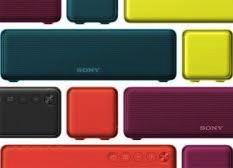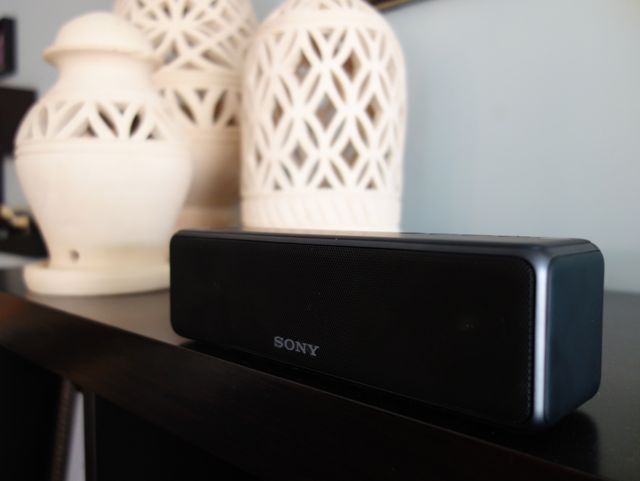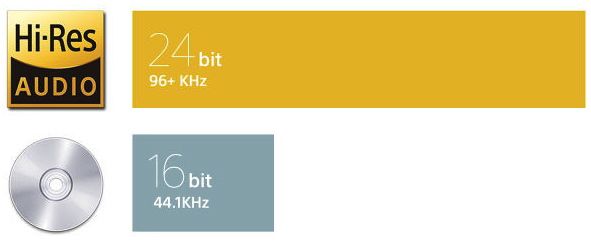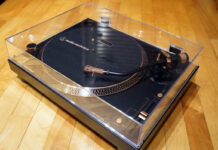
If you are new to the world of Wi-Fi networked wireless speakers you are not alone. This is a market segment that has really taken flight recently, and the Sony h.ear go speaker (coming soon to Best Buy) is an excellent example of where the wireless speaker market is going.
Bluetooth vs Wi-Fi
Traditional Bluetooth technology allows you to connect a wireless device to a speaker and amplify your audio. The difference that Wi-Fi speakers bring is they operate through your home’s wireless network, allowing you to control multiple speakers simultaneously, still through your smartphone or tablet, and have dedicated apps that you use to control them. There is software you can install on your laptop or PC to stream over Wi-Fi from these sources as well, so no matter where you store your music, Sony has you covered.
 There are some networked speakers that do not offer Bluetooth connectivity, and I’m pleased to report the Sony h.ear go offers the best of both worlds for the ultimate in wireless versatility. You can create a network of Sony speakers in your home using Wi-Fi, and in the event you want to take a speaker with to you to the beach or camping, grab a h.ear go and use Bluetooth to stream your favourites when you’re off Wi-Fi.
There are some networked speakers that do not offer Bluetooth connectivity, and I’m pleased to report the Sony h.ear go offers the best of both worlds for the ultimate in wireless versatility. You can create a network of Sony speakers in your home using Wi-Fi, and in the event you want to take a speaker with to you to the beach or camping, grab a h.ear go and use Bluetooth to stream your favourites when you’re off Wi-Fi.
Getting Started
Once you get this speaker out of the box the first thing you will need to do is charge it. The rechargeable battery takes about 5 hours to get a full charge and will provide you with about 12 hours of music using Bluetooth or 8 hours over Wi-Fi. While the unit is charging the first time, you should download the Sony SongPal app, easily found on the App Store or Google Play. The app will walk you through each remaining step to along the way to connect the speaker through Bluetooth or your Wi-Fi network, making it a simple and straightforward process.
 SongPal App
SongPal App
Let’s Make Some Noise!
Streaming music to the h.ear go over Bluetooth is a pretty foolproof method of enjoying your music, and if that is how you want to use this speaker you won’t be disappointed. It would, however, be like purchasing a smartphone only to never send a text, use the camera, or download any of the apps that have changed the way we interact with the world around us. The evolution of wireless speakers is quite exciting, and should be enjoyed.
Once you have the SongPal app installed, the steaming possibilities open up rather dramatically and allow you to tap into streaming services such as Google Play and Spotify in addition to your own music collection.
The App Has An EQ!
One of the really cool features this speaker has with the app is an equalizer with both a custom setting and a couple of preset options, and what a difference this can make! One of the presets is for background music, another is for outdoors, which I found really opened up the speaker. When listening in an open concept space like my home, the outdoor setting really made a difference in the overall quality of the audio inside as well.
There is also an Extra Bass setting, which I usually avoid, however I found that in the larger open concept space did produce a more full range sound without being too low end heavy so long as I wasn’t really close to the speaker. Predictably, in a smaller space I didn’t enjoy it at all and left it off.
 You Get A Speaker, And You Get A Speaker, And You Get A Speaker!!
You Get A Speaker, And You Get A Speaker, And You Get A Speaker!!
This is how I envision Oprah entering each room the day she sets her home up with a Wi-Fi speaker system. The major benefit of networked speakers is you can place them all over your home and have music playing through any or all of them at once. It means you no longer need to run cables through your walls or install ceiling speakers to enjoy music in any room.
Imagine having a party where everyone all over the home can enjoy music, and it doesn’t need to make a few ears bleed for those who get stuck next to the main speakers. You get the benefits of multi-room audio without any of the hard work, construction, or need for a separate amplifier.
Double Down For Stereo Sound
Music is recorded in stereo, meaning there is a left field and a right field, and when heard with a left and right channel they create a “soundstage.” This soundstage opens up the music and provides the listener with a more enjoyable experience. Traditionally, one of the downsides to wireless speakers is that both left and right fields are crushed into a mono speaker and the soundstage completely disappears. One of the great features of the Sony h.ear go is if you have a second speaker you can assign one of them to the left and the other to the right channel and get your stereo sound back.
 Surround Channels in a Home Theatre
Surround Channels in a Home Theatre
Another cool feature that Sony has built into these little speakers is the option to pair them to a compatible Sony sound bar or AV receiver and use them as the surround channels. It is a neat concept and would be a nice upgrade for those who do not currently have any surround sound capabilities in their homes.
Digital-Analogue Converters
Digital technology, streaming services, and wireless broadcasting continue to revolutionize how accessible music is for the masses. The compromise we all make is in the quality of the audio. Even from the early days of CD’s, audiophiles correctly pointed out that a compressed series of 1’s and 0’s could never fully replicate the sound of a traditional analogue source such as vinyl. The more we compress music, the more dynamic range, clarity, and soul we lose.
For many, this may never be a problem because you have never heard a vinyl recording of your favourite music, and you are completely satisfied with the music you love as you know it. For others, the compromise is too great, hence the resurgence of vinyl.
For those in the middle of that pack there is the digital-analogue converter, or DAC, which takes a compressed digital music file and converts it into an analogue-like experience. There is a vast market for DACs, and you can easily drop thousands of dollars on high-end converters. The h.ear go utilizes a DAC and can be accessed through connecting your speaker via USB to a source device. While I did notice a difference in the audio quality, it was not compelling enough for me to keep the speaker connected to a computer.
 High Res Audio
High Res Audio
High Res Audio files essentially eliminate the need for a DAC because they are already upscaled to the more analogue-like state that a DAC is designed to output. The h.ear go speaker is equipped with technology to play these files back, however you need to purchase high res files from a music service in order to enjoy the upgraded audio quality.
When using a small, portable wireless speaker there are certain compromises that are inevitable. It will never compete with a dedicated home theatre setup, and it’s not intended to. Overall, I was quite happy with the Sony h.ear go speaker. It is small and unobtrusive, provides ample flexibility and wireless streaming options, and for providing background music around the house is a quality speaker.
See a huge selection of Sony Wireless speakers at Best Buy



